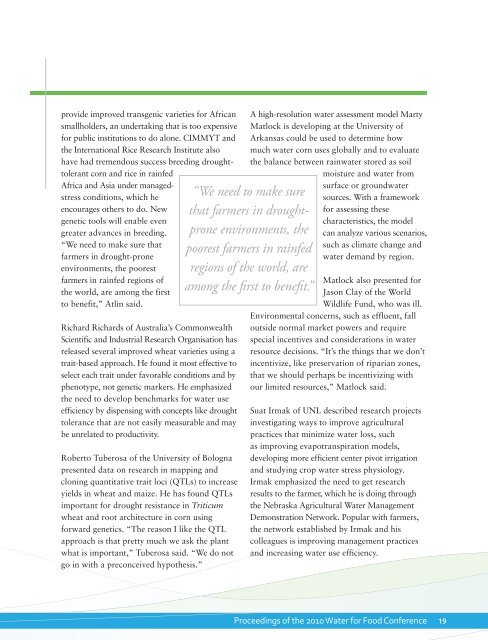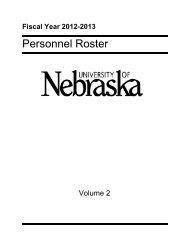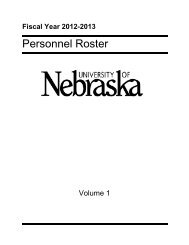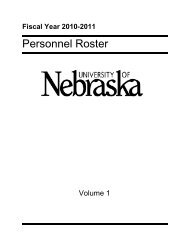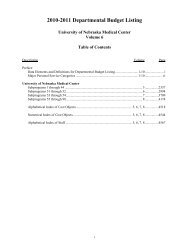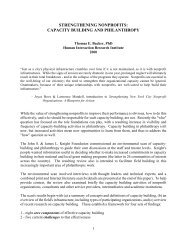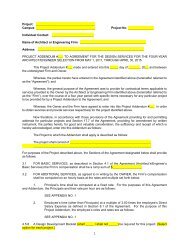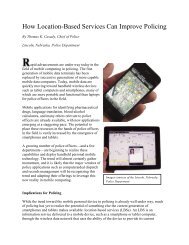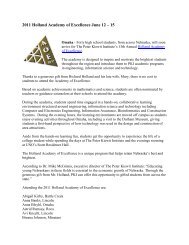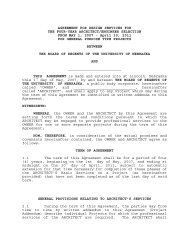Full Version - Water for Food Institute - University of Nebraska
Full Version - Water for Food Institute - University of Nebraska
Full Version - Water for Food Institute - University of Nebraska
Create successful ePaper yourself
Turn your PDF publications into a flip-book with our unique Google optimized e-Paper software.
provide improved transgenic varieties <strong>for</strong> African<br />
smallholders, an undertaking that is too expensive<br />
<strong>for</strong> public institutions to do alone. CIMMYT and<br />
the International Rice Research <strong>Institute</strong> also<br />
have had tremendous success breeding droughttolerant<br />
corn and rice in rainfed<br />
Africa and Asia under managedstress<br />
conditions, which he<br />
encourages others to do. New<br />
genetic tools will enable even<br />
greater advances in breeding.<br />
“We need to make sure that<br />
farmers in drought-prone<br />
environments, the poorest<br />
farmers in rainfed regions <strong>of</strong><br />
the world, are among the first<br />
to benefit,” Atlin said.<br />
Richard Richards <strong>of</strong> Australia’s Commonwealth<br />
Scientific and Industrial Research Organisation has<br />
released several improved wheat varieties using a<br />
trait-based approach. He found it most effective to<br />
select each trait under favorable conditions and by<br />
phenotype, not genetic markers. He emphasized<br />
the need to develop benchmarks <strong>for</strong> water use<br />
efficiency by dispensing with concepts like drought<br />
tolerance that are not easily measurable and may<br />
be unrelated to productivity.<br />
Roberto Tuberosa <strong>of</strong> the <strong>University</strong> <strong>of</strong> Bologna<br />
presented data on research in mapping and<br />
cloning quantitative trait loci (QTLs) to increase<br />
yields in wheat and maize. He has found QTLs<br />
important <strong>for</strong> drought resistance in Triticum<br />
wheat and root architecture in corn using<br />
<strong>for</strong>ward genetics. “The reason I like the QTL<br />
approach is that pretty much we ask the plant<br />
what is important,” Tuberosa said. “We do not<br />
go in with a preconceived hypothesis.”<br />
A high-resolution water assessment model Marty<br />
Matlock is developing at the <strong>University</strong> <strong>of</strong><br />
Arkansas could be used to determine how<br />
much water corn uses globally and to evaluate<br />
the balance between rainwater stored as soil<br />
moisture and water from<br />
“We need to make sure<br />
that farmers in droughtprone<br />
environments, the<br />
poorest farmers in rainfed<br />
regions <strong>of</strong> the world, are<br />
among the rst to benet.”<br />
surface or groundwater<br />
sources. With a framework<br />
<strong>for</strong> assessing these<br />
characteristics, the model<br />
can analyze various scenarios,<br />
such as climate change and<br />
water demand by region.<br />
Matlock also presented <strong>for</strong><br />
Jason Clay <strong>of</strong> the World<br />
Wildlife Fund, who was ill.<br />
Environmental concerns, such as effluent, fall<br />
outside normal market powers and require<br />
special incentives and considerations in water<br />
resource decisions. “It’s the things that we don’t<br />
incentivize, like preservation <strong>of</strong> riparian zones,<br />
that we should perhaps be incentivizing with<br />
our limited resources,” Matlock said.<br />
Suat Irmak <strong>of</strong> UNL described research projects<br />
investigating ways to improve agricultural<br />
practices that minimize water loss, such<br />
as improving evapotranspiration models,<br />
developing more efficient center pivot irrigation<br />
and studying crop water stress physiology.<br />
Irmak emphasized the need to get research<br />
results to the farmer, which he is doing through<br />
the <strong>Nebraska</strong> Agricultural <strong>Water</strong> Management<br />
Demonstration Network. Popular with farmers,<br />
the network established by Irmak and his<br />
colleagues is improving management practices<br />
and increasing water use efficiency.<br />
Proceedings <strong>of</strong> the 2010 <strong>Water</strong> <strong>for</strong> <strong>Food</strong> Conference 19


